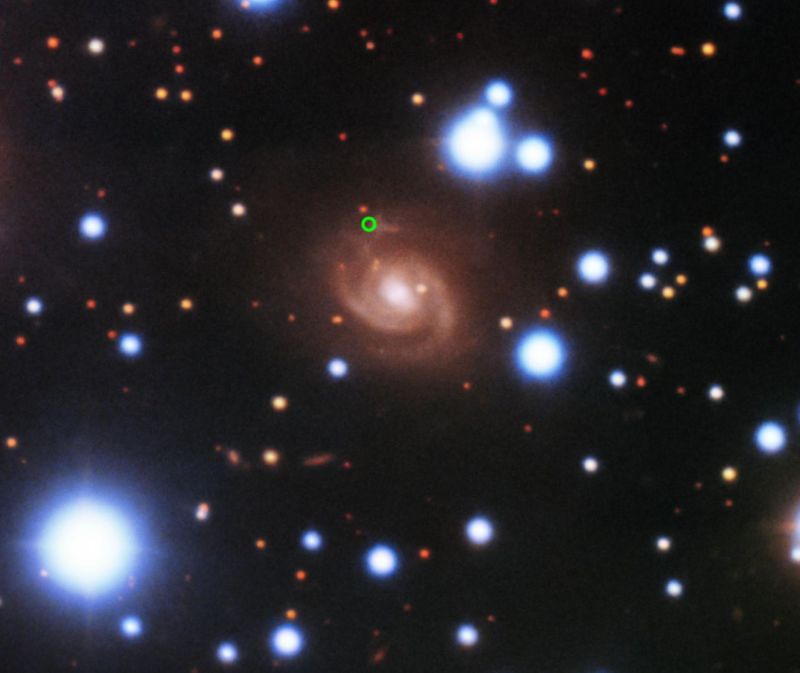
Over a decade after their discovery, fast radio bursts remain an enigma. Often lasting less than a millisecond, the bursts release an incredible amount of energy in the radio frequencies, then go silent. In many cases, there's no indication of anything else happening near that location again, suggesting a catastrophic event that destroyed whatever produced it. But over time, a handful of repeating burst sites have been identified, allowing the galaxy of at least one source to be identified and a few inferences about its properties to be inferred.
But the identification of repeating sources hasn't cleared up as much of the mystery as we might hope. In fact, it has raised questions about whether repeating and lone events might be from entirely different sources.
On Monday, researchers described the closest repeating fast radio burst yet identified, as well as the identity of its host galaxy. And in analyzing the burst's behaviors, the scientists involved suggest that it favors a few existing ideas but should cause us to rethink a few others.
Hitting repeat
It's hard to characterize something that appears without warning, lasts for a few milliseconds at most, and then vanishes, never to be seen again. Still, scientists have managed to identify a few galaxies that seem to be in the same location as a one-shot fast radio burst. These tend to be older, massive elliptical galaxies or those that are rapidly forming stars. In contrast, the one repeating fast radio burst that has been located comes from a dwarf galaxy that isn’t forming many stars and hasn’t gone through multiple rounds of star birth and death. That, in part, led scientists to question whether one-shots and repeaters were from the same source.
Conveniently, a telescope originally designed to do something else happened to be very good at picking up fast radio bursts. The Canadian Hydrogen Intensity Mapping Experiment, or CHIME, was built in southern British Columbia to map the distribution of hydrogen across much of the sky. But it does so at radio frequencies and by imaging a broad area of the sky at once, making it perfect for picking up fast radio bursts. In fact, it managed to identify one while the instrument was still being calibrated.
Earlier this year, a team that formed to search for fast radio bursts announced that it had found eight new repeating sources, providing a substantial catalog to characterize. This week, the researchers described one of that list, FRB180916.J0158+65, in more detail. After picking up a total of four bursts, they were able to identify the galaxy it originated in, as well as the region within the galaxy.
Although describing anything that's a half-billion light years away as "close" is a stretch, FRB180916 turned out to be the closest known repeating burst source by at least a factor of six (others we're aware of may be closer but are not this well characterized yet). It's at least six times closer than the next-nearest repeater that's been assigned to a specific galaxy. That proximity has an interesting consequence: telescopes have been able to pick up weaker bursts from it that might have faded into the background noise had the bursts come from a more distant source.
This, in the words of the researchers, "underscores the fact that the detectability of repetition depends on instrumental sensitivity and source proximity." Put differently, it's possible that all sources repeat to a degree, but we haven't seen it because the sources are too far for the signal to be readily detected. That would argue against the idea that single-shot bursts and repeaters are generated by distinct phenomena.
Idea killer
But this isn't the only thing that argues against separate sources. One of the other reasons to think they might be different was the fact that the repeating burst seemed to come from an extreme environment with intense magnetic fields—an environment present in a dwarf galaxy. The galaxy identified as hosting the new fast radio burst, in contrast, looks a lot like the Milky Way. It's at least 100 times more massive than the dwarf galaxy and contains a much larger percentage of heavier elements. In addition, there's little sign of the intense magnetic fields that left their mark on the other repeating bursts.
So while bursts can be launched from an environment dominated by intense magnetic fields, that's not a requirement. And the galaxies that host repeated bursts aren't necessarily dissimilar from the ones from which one-time bursts appear to be coming. Overall, it remains possible that we're dealing with a single phenomenon. But we're no closer to understanding the mechanism that produces it.
What is clear is that it's not happening at the center of the galaxy, so we can probably rule out supermassive black holes. Instead, FRB180916 appears to originate from the pointy end of a V-shaped star forming region. There don't appear to be any major sources of radiofrequency radiation in this location outside of the bursts.
In many ways, this discovery seems to kill of some of the ideas that had been developing about these strange events. But it does provide the closest and best-localized example of a repeating burst site yet. Hopefully, time and further data will allow us to observe more bursts and allow FRB180916 to start supporting some of our ideas rather than undermining them.
Nature, 2020. DOI: 10.1038/s41586-019-1866-z (About DOIs).
"fast" - Google News
January 08, 2020 at 04:20AM
https://ift.tt/300cCvz
Closest-ever fast radio burst makes some ideas on their origin less likely - Ars Technica
"fast" - Google News
https://ift.tt/2VRmxBz
Shoes Man Tutorial
Pos News Update
Meme Update
Korean Entertainment News
Japan News Update
No comments:
Post a Comment